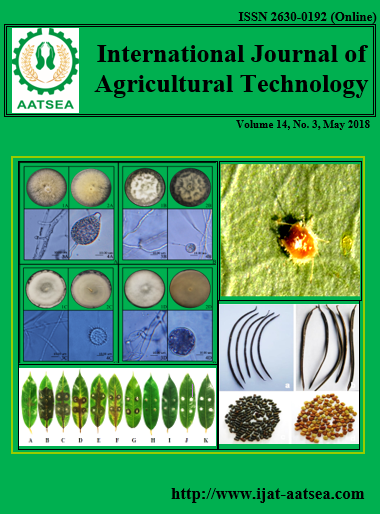High Fiber Enrichment of Khao-Tang as a Thai Style Rice Cracker using Red Seaweed (Gracilaria gracilis)
Main Article Content
Abstract
The develop a fibre enriched Khao-Tang, a Thai style rick cracker that is desireable for adults and children was investigated. Five different amounts of powdered Gracilaria (red algae) were added to 200 grams of Jjasmine rice and 2 grams of cassava flour (0, 5, 10, 15 and 20 grams or 2.5%, 5.0%, 7.5% and 10%). Complete randomized design (CRD) was used to determine the optimum level of powdered Gracilaria for rice crackers. Physicochemical characterization was determined for all treatments. Sensory acceptability was undertaken with 30 untrained panelists. Results of sensory evaluation, using 9-point hedonic scale, found that the highest color score was derived from crackers containing 2.5-5%, powdered Gracilaria. The highest texture score was found in the control.The highest overall score for acceptability was found in crackers containing 2.5% powdered Gracilaria.Increasing the amount of powdered Gracilaria in the rice crackers inproved the fibre content, but product quality slightly deceased, in terms of texture, color and overall acceptance.The study showed that rice crackers containing 2.5% powdered Gracilaria should be the optimum formula to consider, having a hedonic score of 7.00±1.11. In 100 gram samples, moisture, protein, lipid, carbohydrates, fibre and ash content were 3.92±0.13g, 7.60±0.17g, 17.80±2.12g, 66.91±2.12g, 2.34±0.42 g, and 1.40±0.14g, respectively. Color values for L* a* and b* were 19.88±0.69, -1.02±0.39 and 5.97±0.39, respectively. Its fracturability and energy were 10.35±0.84 N and 509.27±8.96 kcal/g, respectively.
Article Details

This work is licensed under a Creative Commons Attribution-NonCommercial-NoDerivatives 4.0 International License.
References
Association of Official Agricultural Chemists (2010). Official methods of analysis, 17th edition, Association of Official Analytical Chemists, Arlington VA, U.S.A.
Bacteriological Analytical Manual Online (2001). Chapter 3: Aerobic Plate Count. USFDA. 1 0 pp. (http://www.cfsan.fda.gov)
Briggs, M. R. P. and Smith, S. J. F. (1993). Macroalgae in aquaculture: An overview and their possible roles in shrimp culture. Proceedings conference on marine biotechnology in the Asia Pacific. pp. 137-143.
Bureau of Rice Research and Development (2002). Annual report 2002 rainfed lowland rice breeding program for Upper North and Northeast Thailand. 149 p.
Capo, T. R., Jaramillo, J. C., Boyd, A. E., Lapointe, B. E. and Serafy, J. E. (1999). Sustained high yields of Gracilaria (Rodophyta) grown in intensive large-scale culture. Journal of Applied Phycology 11:143-147.
Glickman, M. (1987). Utilisation of seaweed hydrocolloids in the food industry. Hydrobiology 151/152:31- 47.
Ito, K. and Hori, K. (1989). Seaweed: Chemical composition and potential foods uses. Food Reviews International 5:101-144.
Jahara, J. and Phang, S. M. (1990). Seaweed marketing and agar industries in Malaysia. In BOBP: Gracilaria production and utilization in Bay of Bengal Programme, BOBP/REP. 45:75 -86.
Jensen, A. (1993). Present and future needs for alga and algal products. Hydrobiology 260/261:15-21.
Khao Narong, S. and Kochul, P. (2003). Strach Tecnology. Bangkok: Kasetsart University Press.
Ministry of Industry (2003). Community product standard of shredded pork crispy rice. Document of CPS at 28/2003. Agro product standard office, Bangkok, Thailand.
Renaud, S. M. and Luong-Van, J. T. (2006). Seasonal Variation in the Chemical Composition of Tropical Australian Marine Macroalgae. Journal of Applied Phycology 18:381-387.
Suvannasungkha, K. (2001). Development of high protein and calcium from Fish. (Master’s Thesis). Mahidol University.
Tachasiriwichai, W. (2014). The development of a recipe for cereal grain crispy rice with anchovy calcium. (Master’s Thesis). Ramkhamhaeng university.
Zydenbos, S and Humphrey, T. V. (2003). Biscuits, cookies and crackers – nature of the products. In: Encyclopaedia of Food Sciences and Nutrition. Gallery Article No. 0103.


